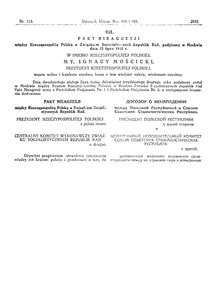Polish-Soviet non-aggression pact
The Polish-Soviet non-aggression pact ( Polish Polsko-radziecki pakt o nieagresji , Russian Польско-советский договор о ненападении ) was an international treaty between the Soviet Union and Poland, which was signed on July 25, 1932 between representatives of both states. It provided for the renunciation of a mutual attack.
After the outbreak of the Second World War , triggered by the attack on Poland on September 1, 1939 by Nazi Germany , the treaty was broken by the attack on eastern Poland . Germany had signaled its agreement to this in a secret additional protocol to the German-Soviet non-aggression pact on August 23, 1939.
background
After the Polish-Soviet War (1919–1921), the Polish government pursued a policy of equal distance from the Soviet Union and the German Empire. Most Polish politicians were betting on an alliance with France and on not supporting either Germany or the USSR. Negotiations with the USSR began as early as 1926 to conclude a non-aggression pact. The peace of Riga should be strengthened and an agreement with the German Reich should be sought. Negotiations were interrupted in June 1927 when Great Britain broke off diplomatic relations with the Soviet Union and Soviet Plenipotentiary Pyotr Woikov was murdered in Warsaw . In 1931 negotiations were resumed in Moscow and the pact was signed on July 25, 1932. It was initially valid for a period of three years. The pact was ratified on December 23, 1932. On January 9, 1933, he was deposited with the League of Nations Treaty Series . On May 5, 1934, the pact was extended to December 31, 1945. The contracting parties assured themselves to refrain from aggressive actions and neutrality in the event of attacks by third parties.
On September 23, 1938, the Soviet Union informed Poland that the pact would be considered null and void if Poland were to occupy parts of Czechoslovakia in violation of international law . When Poland disregarded this and illegally annexed parts of the neighboring country ( Olsa area and Arwa-Zips area strip ), the Soviet Union did not react.
On November 26, 1938 - despite the statement made by the Soviet government on September 23 - the validity of the contract was mutually confirmed and extended for a further 5 years (until December 5, 1945).
The pact was seen as an interim triumph for Polish diplomacy. This was mainly because Poland's relations with its western ally France had not improved in the previous years and Warsaw's negotiating position with Berlin was strengthened by the non-aggression pact with Moscow. Eighteen months after the pact, the German-Polish non-aggression pact was concluded on January 26, 1934 , which was unilaterally terminated by Nazi Germany on April 28, 1939.
literature
- Oleg Ken: Moskva i pakt o nenapadenii s Pol'shey ('Moscow and the Non-Aggression Treaty with Poland') . PIAF of Russian Academy of Sciences , Saint Petersburg 2003, ISBN 5-86763-136-2 , p. 129.
- Oleg Ken: Collective security or isolation? Soviet foreign policy and Poland, 1930-1935 . Evropeyski Dom, St. Petersburg 1996, ISBN 5-85733-057-2 , p. 328.
- Jan Tomasz Gross : Revolution from Abroad . Princeton University Press, Princeton 2003, ISBN 0-691-09603-1 , p. 396.
- Edmund Jan Osmańczyk : Encyclopedia of the United Nations and International Agreements . Routledge (UK), 2002, ISBN 0-415-93923-2 , p. 1817.
Web links
Individual evidence
- ^ League of Nations Treaty Series , vol. 136, pp. 42-53.
- ↑ [1]
- ↑ [2]
- ↑ Stosunki między Polską a ZSRR , Republika, November 27, 1938, p. 1.
- ^ Chronology 1938 , League of Nations Archives
